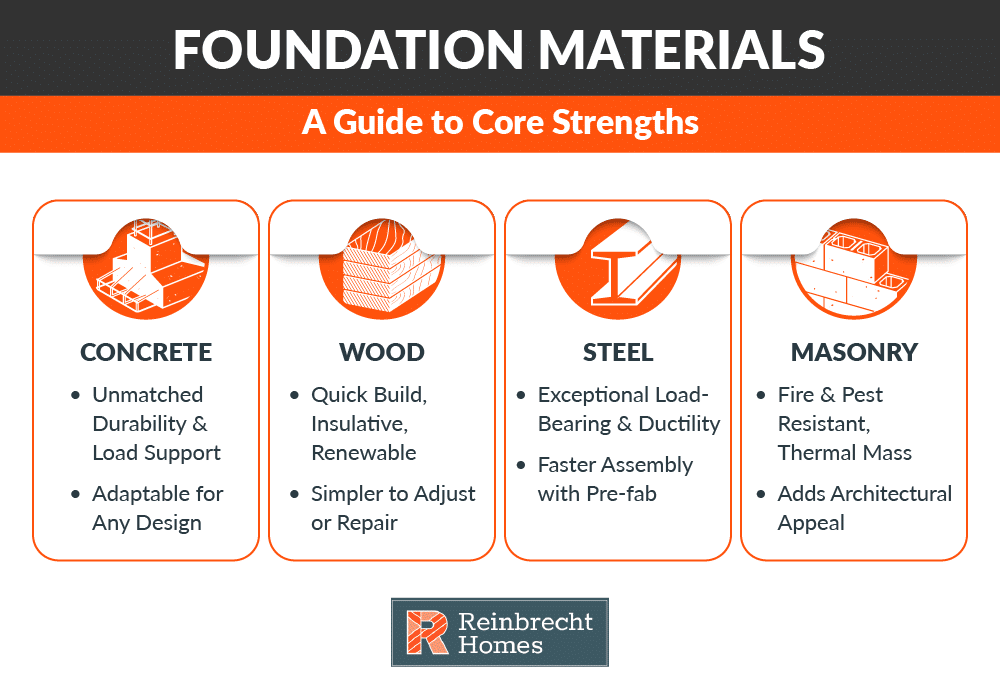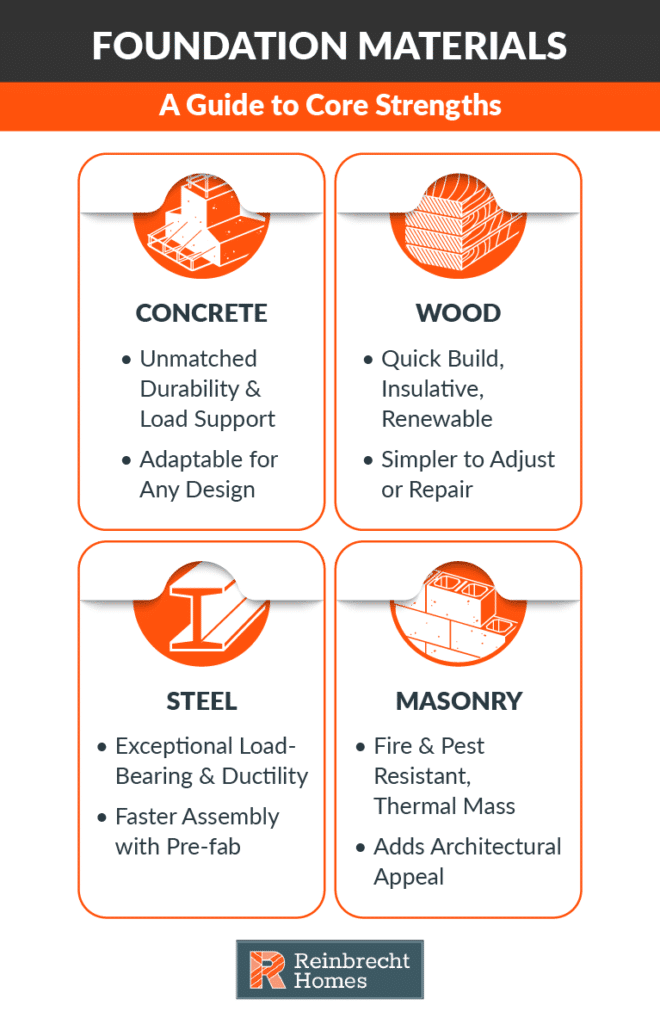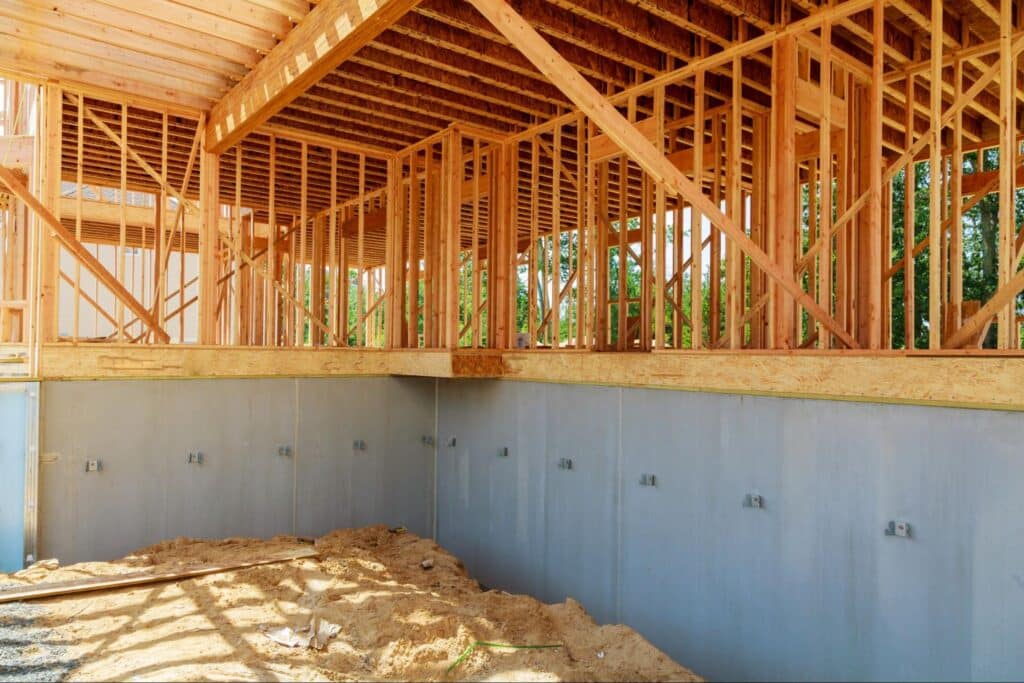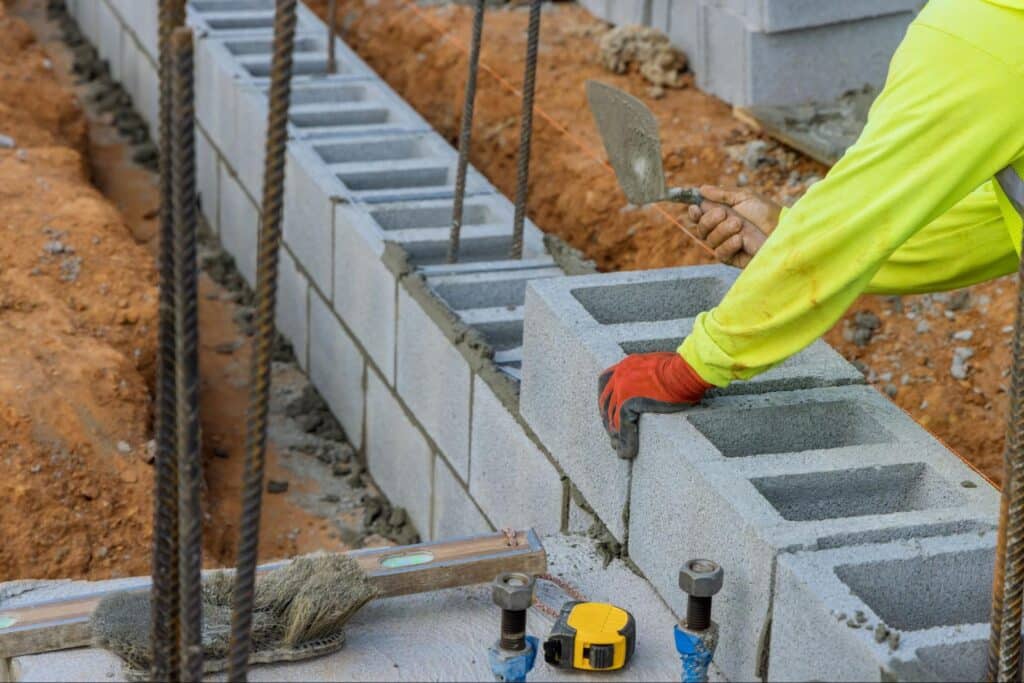The success of any construction project begins with a solid foundation. Serving as the critical link between a building and the ground, a foundation does more than just bear weight—it must distribute structural loads, manage moisture, and withstand environmental pressures like soil movement and water infiltration. Choosing the right material is therefore one of the most crucial decisions you’ll make, impacting everything from long-term stability and safety to cost and environmental footprint.
In this guide, we explore the four primary foundation materials—concrete, wood, steel, and masonry—to help you select the perfect system for your project’s unique needs.
Key Questions to Ask Before Choosing a Foundation
Choosing the right foundation material depends on your specific project. Before exploring the options, answer these critical questions to create a blueprint for your decision:
- Site & Soil: What are my soil conditions? Do I have expansive clay, sandy soil, or a high water table?
- Structural Demands: How heavy will my building be? Is it a single-story home or a multi-story structure?
- Climate Challenges: What environmental pressures will the foundation face? (e.g., freeze-thaw cycles, high humidity, flooding, or seismic activity).
- Budget & Timeline: What is my realistic budget for the foundation, and how quickly does it need to be installed?
- Sustainability Goals: How important are renewable materials and a low carbon footprint to my project?
- Long-Term Vision: What are the expected maintenance needs, and does the material’s lifespan align with my goals?
A Comparative Look at Foundation Materials


Concrete Foundations
Concrete is the most widely used foundation material due to its durability, strength, and versatility. It is composed of cement, water, and aggregates (sand, gravel, or crushed stone) that harden through hydration. Known for significant compressive strength, concrete provides a robust base capable of supporting heavy loads. Its moldability allows it to be cast in various shapes, accommodating different structural designs. When reinforced concrete elements such as steel bars are added, the material’s tensile capacity increases, making it suitable for a broad range of construction applications.
Advantages of Concrete Foundations
- Durability and Longevity: When properly mixed and cured, concrete can last for decades with minimal maintenance.
- Excellent Load Support: Suitable for large, multi-story buildings and other heavy structures.
- Versatility: Adaptable to everything from slab-on-grade foundations to full basements.
- Fire Resistance: Concrete naturally resists fire, contributing to enhanced safety.
Disadvantages of Concrete Foundations
- Cracking Risks: Temperature fluctuations, soil movement, and improper curing can all lead to cracking.
- Environmental Footprint: Cement production is energy-intensive, leading to higher CO2 emissions.
- Complex Installation: Requires skilled labor and careful engineering, making it critical to follow best practices.
Wood Foundations
Wood foundations offer a traditional alternative that remains viable for specific applications, particularly in low-rise residential projects or in regions where speed of installation is essential. With proper waterproofing, insulation, and drainage, wood foundations can perform well even in colder or more humid climates. Typically constructed from pressure-treated lumber and plywood, these foundations are designed to resist decay and pest damage when installed with correct techniques.
Built primarily using treated lumber, wood foundations are relatively light, easy to modify, and can be insulated effectively. Advances in treatment methods have improved their durability; however, thorough waterproofing steps remain essential to resist moisture and insects.
Advantages of Wood Foundations
- Quick Construction: Wood foundations can be erected rapidly, cutting down on project timelines.
- Cost-Effectiveness: In remote areas where concrete is difficult to transport, wood offers a more practical alternative.
- Sustainability: Responsibly harvested wood is renewable and tends to have a lower carbon footprint.
- Thermal Benefits: Wood naturally provides insulation, helping manage indoor temperatures.
- Ease of Adjustment: Extensions or repairs are simpler compared to other foundation types.
Disadvantages of Wood Foundations
- Moisture Sensitivity: Even with treatments, wood can degrade if exposed to standing water or long-term high humidity.
- Pest Risks: Proper sealing and regular inspections are necessary to keep termites and other pests at bay.
- Building Code Constraints: Not all jurisdictions encourage or easily approve wood foundations, so it’s important to check with local authorities.
Steel Foundations
Steel foundations bring exceptional load-bearing capabilities to projects that require high strength or must contend with difficult soil conditions. Boasting a high strength-to-weight ratio, steel can support substantial loads with relatively minimal material. Steel’s ductility also helps it adapt to movement or stress—an advantage in earthquake-prone areas. However, ensuring effective corrosion protection is key in moist or aggressive environments, where coatings or special alloys may be required.
Advantages of Steel Foundations
- Robust Load Capacity: Ideal for infrastructure that must bear significant weight, such as industrial or tall commercial projects.
- Customizable Installation: Steel piles, for instance, can be driven or drilled into the ground to suit varying soil profiles.
- Faster Assembly: Prefabricated components can accelerate on-site work.
- Recyclability: Steel can be recycled multiple times, aligning with green building objectives.
Disadvantages of Steel Foundations
- Corrosion Concerns: Steel must be adequately protected through coatings or galvanization to prevent rust.
- Higher Initial Cost: Manufacturing and specialized installation can elevate upfront expenses.
- Complex Logistics: Steel is often best handled by teams with specialized equipment and experience.
Masonry Foundations
Masonry foundations, which may include brick, stone, or concrete blocks, are prized for a combination of structural reliability and timeless visuals. Masonry stands out for its high compressive strength, built-in fire resistance, and appealing surfaces. Modern concrete blocks can be reinforced internally with steel or grout to address structural needs, and natural stone inherently resists pests and decay.
Advantages of Masonry Foundations
- Fire and Pest Resistance: Masonry is naturally resilient against both flames and pests.
- Thermal Mass: The material’s mass helps moderate interior temperatures by retaining heat and releasing it slowly, improving energy efficiency.
- Architectural Appeal: The look of brick or stonework can enhance a building’s overall design.
- Longevity: With low maintenance demands, masonry can last for generations.
Disadvantages of Masonry Foundations
- Heavier Material: Masonry requires stable ground conditions and well-prepared footings to support its weight.
- Susceptibility to Cracks: Without adequate reinforcement, masonry can crack if soil shifts significantly.
- Labor-Intensive: Installation typically takes more time and specialized skill, potentially raising costs.
Innovations and Best Practices for a Future-Proof Foundation

Selecting the right material is only the beginning. A truly successful foundation is the result of a forward-thinking strategy that integrates cutting-edge innovations with timeless construction principles. By adopting modern best practices, you can build a foundation that is not only strong today but also resilient, sustainable, and ready for the future.
Here are the essential steps to ensure your foundation project is a lasting success:
1. Start with the Ground Truth: A Thorough Site Analysis
Before any material is chosen, a professional soil test is non-negotiable. This analysis reveals critical data on load-bearing capacity, drainage, and potential soil movement. The results will guide your decisions, pointing toward the ideal solution—whether it’s a standard concrete slab or an innovative hybrid system engineered to handle the unique challenges of your specific site.
2. Master Moisture from Day One
Water is the primary enemy of any foundation. A proactive moisture management plan is crucial, especially in humid climates or areas with freeze-thaw cycles. This includes:
- Proper Drainage: Installing systems like French drains to channel water away from the foundation.
- Effective Barriers: Using modern vapor barriers and waterproof coatings to seal out moisture.
- Leveraging Advanced Materials: Innovations like engineered wood products offer enhanced moisture resistance, while new additives can make concrete less porous, providing an extra layer of defense.
3. Build Smarter with Sustainable and High-Performance Materials
The definition of a “good” material is evolving. Today, it includes performance, durability, and environmental impact. Discuss these modern options with your builder:
- Greener Concrete: Reduce your carbon footprint with recycled concrete aggregates or geopolymer alternatives, which use industrial byproducts instead of traditional cement.
- Next-Generation Strength: Ask about high-performance concrete (HPC), which offers superior durability and a longer lifespan, protecting your investment for decades.
- Smart Foundations: For ultimate peace of mind, consider incorporating embedded sensors that monitor structural health, moisture levels, and temperature in real time. This technology transforms maintenance from a reactive chore into a proactive strategy.
4. Ensure Flawless Execution with Skilled Professionals
Even the most advanced materials will fail if not installed correctly. Your project’s success hinges on the expertise of your team. Work with experienced structural engineers and contractors who understand the nuances of the materials you’ve chosen and are up-to-date on the latest installation techniques.
5. Navigate Regulations and Plan for the Future
Always consult local building authorities early to confirm that your chosen materials and designs comply with regional codes. At the same time, think about your long-term vision. Do you plan to add another story or a basement down the road? Designing your foundation to accommodate potential future expansions from the outset is a smart, cost-effective strategy that ensures your home can grow with you.
Foundation Essentials for Lasting Construction Success
Foundations are the unsung heroes of construction, providing the necessary stability for a building’s long-term success. By understanding the properties, advantages, and limitations of each option—be it the unmatched durability of concrete, the natural insulation offered by wood, the strength of steel, or the timeless aesthetic of masonry—you can confidently navigate the complexities of foundation design. Moreover, modern innovations—from smart foundations to advanced moisture management—ensure that your foundation will serve its purpose well into the future.
Investing in the right foundation means investing in your future. Make decisions based on your site conditions, structural needs, and sustainability goals. If you’re looking for more insights into construction and how best to customize your foundation selection, contact Reinbrecht Homes to learn how our expertise can help you achieve a stable, high-quality build.

